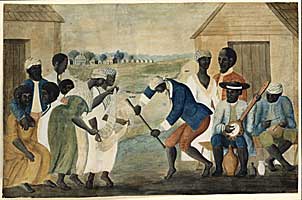Students of American slavery are faced with a daunting task: Try to form an accurate picture of the slave experience when the vast majority of primary sources are memories from white slave owners and outside observers. White diaries and recollections often tend toward caricatures, employing stereotyping of slave speech and folkways. These stories were intended to entertain, rather than elucidate. Even more perverse are the many white recollections of the slave experience downplaying the horrors of the evil institution in support of the Lost Cause myth. Most published accounts are motivated not by a desire for historical accuracy, but rather by a crude attempt to manipulate memory.
Open most any local history from a Southern town written in the first half of the 20th century and you will find examples such as this from George Magruder Battey, Jr.’s 1922 classic, A History of Rome and Floyd County:
LOVE FOR OLD SLAVES. – The tender bond of sentiment existing between master and slave in the ante-bellum days is an old story, and it has plenty of verification in fact. While it is quite true that there were occasional instances of cruelty and oppression, as a rule master and mistress treated the slaves with great consideration. Few people would want slavery re-established, yet it is interesting to take note of instances in which slaves were treated almost like members of the family by the “white folks.”
Sadly, Battey’s volume remains the best-selling work on local history in northwest Georgia, reinforcing distorted mental images like the “faithful slave” over successive generations.
The University of North Carolina documents only 132 memoirs written by former slaves themselves. Slave reminiscences tell us as much about the social and political context at the time of their writing as they do about the subject’s past experience of slavery. Some scholars question the veracity of certain antebellum autobiographies as being part of an abolitionist propaganda effort. Others appear designed to gloss over the harsher realities of slavery in an effort to heal the nation’s sectional divide following the Civil War.
Not surprisingly, slave biography in the United States became a popular genre about the time of the founding of the American Anti-Slavery Society in 1833. By the end of the decade, 16 such works had been published in a span of 13 years. Slave reminiscences declined to just three in the 1840s, as those advocating immediate abolition came to be viewed as a radical minority in the North. Another surge of slave biographies mirrored the increased political tensions following the passage of the Fugitive Slave Law of 1850, and the publishing of Uncle Tom’s Cabin in 1852. Twenty such works hit booksellers in the decade leading up to the Civil War, as antislavery activists sponsored escaped slaves eager to tell their tales.
The popularity of slave biography ebbed in years following the Civil War. Even as lynching became common throughout the South in the early 20th century, local newspaper editors and Confederate veteran organizations worked hard to create literature extolling the “bright side of slavery,” as on Tennessee veteran called it. Nostalgia for the good old days dominated most slave narratives and serious scholarship took a back seat to the invention of a sanitized antebellum South.
Interest in slave biography accelerated over the last half of the 20th century, beginning with the WPA Slave Narrative Collection, a valuable archive of elderly slave remembrances assembled in from 1936-1938. An explosion of interest in black family history in the decades after the civil rights movements of the 1960s gave fresh impetus to the trend. Historian Henry Louis Gates Jr. gave this movement additional momentum with his television series called Finding Your Roots. Black family history has found its way into the pop culture mainstream, in prime time no less. This upsurge in interest, although encouraging, should also give most serious historians pause.
Extant slave biographies and other published recollections should be corroborated by other evidence to bolster the credibility of these first-hand accounts. Since slaves were chattel property, contemporary records do exist, but they are hit or miss. Few offer a comprehensive documentary record of this population in anything but the bare outlines provided in resources such as slave censes and plantation records.
Modern revisionist historians eager to scoop the latest unknown and shocking story or motivated to warp history for present-day political purposes are doing serious damage to black history scholarship. Amateurs and even professionals like John Stauffer (propagator of the controversial black Confederate mythology) take conflicting, scant, or even absent evidence and draw broad conclusions about the slave experience. A more conservative approach is needed to sustain popular interest in slave biography while maintaining scholarly credibility.
Even the most accomplished historians are tempted by the lack of primary sources to cross the line from the interpretation of evidence to the divining of motives and feelings in otherwise silent historical slave characters. In her groundbreaking book, The Hemingses of Monticello, Annette Gordon-Reed examines the family of Thomas Jefferson’s slave mistress, Sally Hemings. While DNA evidence suggests that Jefferson was the father of Hemings’s children, no writings or other direct quotations from her exist. Professor Gordon-Reed makes a brilliant argument in much of the book, and offers her readers new insights into not only Jefferson’s slave family, but also into the man himself. In her zeal to explain why Sally returned to America, when she presumably could have sought asylum and freedom in France, the author relies on the claims of Sally Hemings’s son Madison. He wrote that his mother negotiated a deal with her master and lover to return as a slave to Virginia in exchange for “extraordinary privileges,” and a promise to free her children after his death.
Professor Gordon-Reed takes Madison Hemings’s word as truth, despite the fact that there is no way to corroborate his story. She goes on to fashion an elaborate argument, built on speculation, that Sally Hemings held some sort of special power (love?) over Jefferson. “Like other enslaved people when the all too rare chance presented itself,” the author argues, “Hemings seized her moment and used the knowledge of her rights to make a decision based upon what she thought was best for her as a woman.” If Gordon-Reed is right, this is an incredible discovery, but the historical power dynamics between male master and female slave make such a circumstance as the author posits difficult to imagine, impossible to verify and singular in the annals of American slavery.
Without an interest in the history of this famous family on both the white and black sides, Gordon-Reed’s brilliant book may never have been written. Today’s researchers should cast their nets more broadly and network with family history enthusiasts to uncover potentially promising story leads buried in the archival background of black genealogy. When will scholars embrace the potential for more collaboration between the academy and the millions of diligent, serious family historians, who have been disregarded or looked down on by professionals in the history genre? Trailblazers like Edward Ball (Slaves in the Family) prove that family history can provide a rich contextual starting point for more serious scholarship. Producing more articles and books on slave biography will lead to a richer, more nuanced understanding of the slave experience at a time when the reading and viewing public seems ready for more truth and less myth.
NEXT POST: How I discovered “The Wealthiest Slave in Savannah.”



